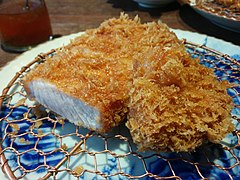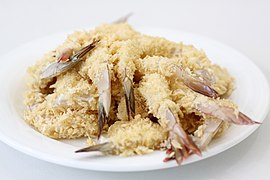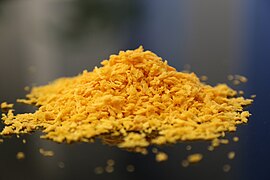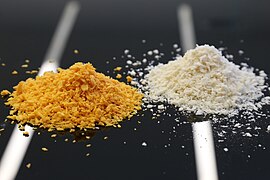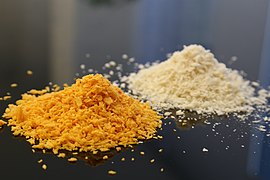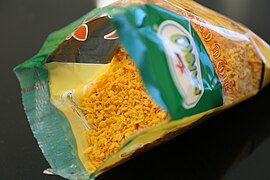Breadcrumbs
This article needs additional citations for verification. (September 2009) |
 Commercially produced breadcrumbs | |
| Alternative names | Breading, crispies |
|---|---|
| Main ingredients | Dried bread |
| Variations | Panko |
Bread crumbs or breadcrumbs (regional variants including breading and crispies) consist of crumbled bread of various dryness, sometimes with seasonings added, used for breading or crumbing foods, topping casseroles, stuffing poultry, thickening stews, adding inexpensive bulk to soups, meatloaves and similar foods, and making a crisp and crunchy covering for fried foods, especially breaded cutlets like tonkatsu and schnitzel. The Japanese variety of bread crumbs is called panko.
Breading
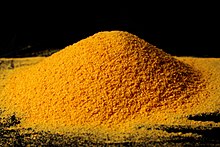
Breading (also known as crumbing) is a dry grain-derived food coating for a piece of food made from bread crumbs or a breading mixture with seasonings. Breading is well suited for frying as it lends itself to creating a crisp coating around the food. Breading mixtures can be made of breadcrumb, flour, cornmeal, and seasoning that the item to be breaded is dredged in before cooking. If the item to be breaded is too dry for the coating to stick, the item may first be moistened with buttermilk, raw egg, egg wash or other liquid.
Breading contrasts with batter, which is a grain-based liquid coating for food that produces a smoother and finer texture, but which can be softer overall.
In popular culture
In the fairy tale "Hansel and Gretel", breadcrumbs are used by Hansel and Gretel to track their footpath. However, the bread crumbs were eventually eaten by birds, subsequently leading them to become lost in the woods. The popularity of breadcrumbs in the fairy tale led to the use of the word "breadcrumb" as a navigation element that allows users to keep track of their locations within programs or documents.[1]
Gallery
-
Bread fried in breadcrumbs and stuffed with chicken and corn
-
Panko breadcrumbs with paprika flavour
-
Panko white breadcrumbs
-
IANS simple breadcrumbs
-
Panko on Tonkatsu
-
Fried shrimp with panko breadcrumbs
-
Shrimp coated by panko breadcrumbs
-
Panko breadcrumbs - white
-
Panko breadcrumbs - paprika
-
Panko breadcrumbs - spicy
-
Panko breadcrumbs - paprika and white
-
Panko breadcrumbs - paprika and white
-
Panko breadcrumbs - paprika
References
- ^ Mark Levene (18 October 2010). An Introduction to Search Engines and Web Navigation (2nd ed.). Wiley. p. 221. ISBN 978-0470526842. Retrieved June 24, 2016.





